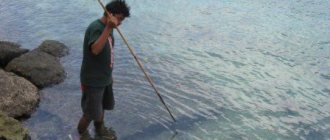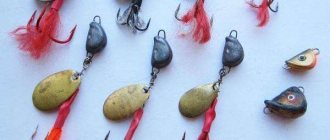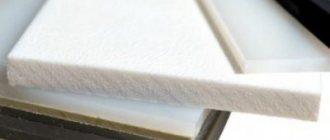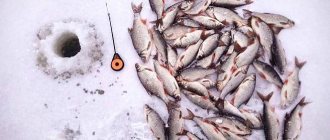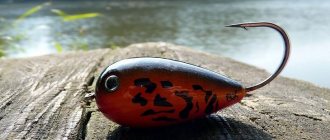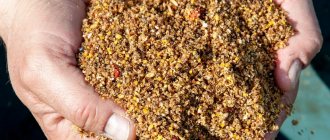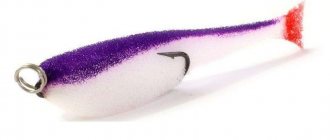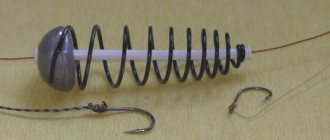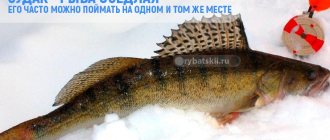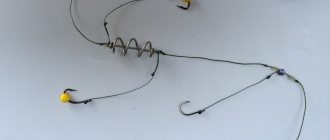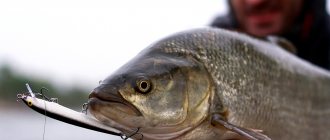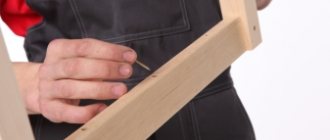Open and plant-free reservoirs are not always suitable for pike fishing. In an overgrown pond or reservoir sump you can achieve much more excellent results. But the spinners and classic wobblers with tees will not swim far here - they will immediately get tangled in the grass or stick into snags. However, there is one option suitable for such conditions - Croatian egg fishing. About the features of this bait, its pros and cons, and its wiring options in this article.
What is a Croatian egg
Croatian egg is a spinning surface bait made of lightweight material: balsa, plastic, cork or foam, and designed for catching pike.
Its rounded part is equipped with a ring for mounting a fishing line, and on the other side there is a hook (single or double). Inside the bait, in the belly, there is a weight. Thanks to this, when wiring, it is always in the hook-up position.
The product is shaped like an egg – hence the unusual name. When making it with their own hands, many fishermen use various available materials, but the classic model is made exclusively from balsa. Its average weight is from 5 to 15 grams.
The official name of this lure is Bumble Lure. It was invented by Branimir Kalinic (pictured below) from Croatia. Russian spinners brought it to their homeland after a bass tournament held in this country in 2006.
About
Manufacturing
Fishermen prefer to make a Croatian egg with their own hands, since it is simply not possible to buy such bait in a store. For reasons unknown, such bait can only be found in online stores, and even then, it will be homemade.
The manufacturing process itself is quite simple, the main thing is that you have all the necessary tools and materials:
- Wine cork.
- File.
- Big single.
- Pliers.
- Hacksaw for metal.
- Stainless steel wire (diameter approximately 0.5 millimeters).
- Lead.
- Waterproof, quick-drying adhesive.
First you need to take a cork and, armed with a file, make something out of it that looks like an egg. Then you need to cut the bait exactly in the center with a hacksaw, starting from the tail and ending with its front part. The cutting width should be about 2.5 millimeters. When using a thick hook, the cut can be slightly wider.
Loading
When the cork has received the shape of an egg, the most interesting part begins - loading it and installing the hook. This is not too difficult, but a painstaking task; first you need to arm yourself with a single hook and a small piece of wire.
Knitting wire is best suited for such purposes, since this material is easily deformed under physical influence
Please note that you need to take hooks with a straight shank; if your single hook has a slight bend, it can be easily straightened out with pliers
Then you need to form a loop at the end of the wire and attach a hook to it. Now try on the resulting blank for the bait
Please note that the blank should be approximately 2/3 of the body length of the bait itself
Now you need to take sheet lead 1 millimeter thick and cut a strip about 10 millimeters wide and the long, even length of the body of the bait itself. Now you need to wrap this strip along the hook blank on the wire, bending it in half.
Read Spinning for beginners - which one to choose and rating of the best models
Load test
It is best to check the buoyancy of the bait at home in a basin of water, since fishermen often overload the Croatian egg with their own hands and get upset when they arrive at the pond. But for the purity of the test, it is necessary to collect all the bait. It is necessary to insert the resulting blank from the lead and hook into the cut of the egg.
It is advisable to ensure that the workpiece does not wobble inside the cut and fits tightly into it. After assembly, you need to lower the resulting bait into the water. The main thing is to choose such a weight of the load so that the hook tip points upward, and the bait itself takes a horizontal position and is half immersed in the water.
It’s easy to guess that by changing the weight of the lead plate you can adjust the immersion depth of the bait. Fortunately, lead is easy to process, so it won’t be too difficult to bite off a small piece or add a little.
If you managed to achieve the correct position of the bait in the water, then the Croatian egg is almost done with your own hands, all that remains is to bring the bait into proper shape. First you need to fill the cut with glue.
Finishing
In its resulting form, the bait is unlikely to attract a predator, so it still needs to be further trimmed and decorated. Any bait should have an attractive and neat appearance, and the Croatian egg is no exception to the rule. Typically, the egg is treated with epoxy resin to achieve the desired appearance.
But first of all, you should thoroughly treat all joints in the bait to prevent water from getting there. The strength and reliability of the entire structure as a whole is ensured by the good fluidity of the resin, which allows it to easily penetrate into the smallest voids in the body of the bait. After the bait is completely dry, you can begin sanding with sandpaper.
Coloring
Many fishermen refuse painting altogether, saying that a Croatian egg with their own hands attracts predatory fish by its movement on the surface, but not by its appearance. But an attractive appearance will never be superfluous, so it is better to decorate the bait to ensure its greater effectiveness.
Most often, the bait is decorated with a random design and it is not at all similar in appearance to the usual fish. Bright and catchy colors used when painting bait do not negatively affect the activity of the predator, so they are often used.
Paint the bait with various colors. Fishermen even use washable paints, but to avoid blurring the design, the bait is coated with colorless varnish. Fishermen who make eggs at an amateur level prefer to paint the bait with regular nail polish. It is water resistant, cheap and holds up well.
Where and when to apply
Thanks to its design, the Croatian egg allows you to fish in areas of reservoirs covered with dense aquatic vegetation, including a continuous carpet of algae.
Some models are equipped with additional “antennae” or silicone feathers, which allows them to be used as non-snags in the most difficult places.
Fishing with such baits is very exciting and dynamic. You literally watch the pike come out of ambush, chase the bait and attack vigorously.
Useful additions
Those who want to make their own Croatian egg are interested in the size of the original. These lures are produced in two sizes: 47 mm and 52 mm. The color range is very diverse. It has been noticed that bright colors have the greatest effect. When jerking, a vibration is created on the surface of the water, the pike pays attention to the moving object, and among the thickets of grass it is easier for it to aim at a fairly large and bright bait.
Spinners often modify the purchased sample. You don’t need any special equipment for this; just add feathering to make the bait even more attractive. As such an addition, the tails of vibrotails or the tentacles of baits, which are called tubes, are used. The second option for pike is more interesting. The best time to catch pike with a Croatian egg begins in mid-summer. You can successfully fish with it until the aquatic vegetation begins to sink to the bottom and it’s time to switch to traditional autumn spoons, wobblers and silicone.
Sources:
https://pike-fish.ru/bait/primanki-na-schuku/lovlya-shhuki-na-xorvatskoe-yajco.html https://ribakclub.ru/lovlja-shhuki-na-horvatskoe-jajco/ https:/ /fishingday.org/lovlya-shhuki-na-xorvatskoe-yajco/ https://www.fishingsib.ru/video/view/132826/ https://schukar.info/snasti-na-schuku/horvatskoe-yaico.html https://samrybak.ru/lovlya-na-horvatskoe-yaytso.html
Kinds
The Croatian spinning egg comes in 2 shapes:
- Popper - there is a recess on the front round part that creates a gurgling sound and splashes when wiring. It has a long hook. Popper works better in more open areas, in windows of vegetation.
- Walker - its ovoid shape without cuts or irregularities gives sliding properties, and the bait does not catch on the grass, because the shank of the hook is directed upward. Suitable for catching predators where there is a lot of vegetation.
Photo: Croatian egg bait and its varieties - popper (left) and wolfer (right)
Advantages and disadvantages
First, let's look at the strengths of the bait:
- Long casting – thanks to the rounded shape and position of the weight, the Croatian egg has good aerodynamics.
- When reeling, the bait creates a strong vibration in the water, which looks impressive and even attracts fish from afar, provoking it to bite.
- The Croatian egg does not catch on grass and snags, like spinners, wobblers-poppers, etc. The ovality and well-thought-out weight make it a “tumbler”, and it always remains with the hook up. Sometimes this is the only spinning bait that can be used in densely overgrown ponds or peat bogs.
Photo: Croatian egg Akara Crazy Egg 55F, color options
Despite the advantages, the bait also has its disadvantages:
- used for fishing in warm water when fish hunt closer to its surface;
- The bait is made of fragile material, and pike bites through it easily. The Croatian egg can then absorb water in places of damage and lose its shape, becoming unusable faster than other types of bait. Therefore, fishermen try to use such equipment in heavily overgrown reservoirs, where other options will not work or to attract sluggish fish;
- For 10 bites, there may be only 2-3 fish caught, because it can grab a round bait from the side or break off a single hook.
Tip: you can increase the effectiveness of bites by hanging a twister on the hook that imitates a worm - its game will make the “Croatian” even more attractive to predators.
Bait finishing
A predator may not be interested in a simple bait without preliminary finishing. The “egg” should have a neat and attractive appearance. The finishing of the “egg” can be done using epoxy resin. By the way, you can add watercolor paints to epoxy resin and paint the “egg”. But first, you need to fill the junction of the hook with the wire and the weight with the “egg” itself with epoxy resin. Epoxy resin has good fluidity, so it will fill the smallest voids and make the structure strong and reliable. After complete hardening, the “egg” can be treated with sandpaper.
Catching pike with a Croatian egg
To attract pike, the following types of wiring are used:
- Light jerks - the bait moves in a straight line with a small amplitude.
- Uniform with speed adjustment - the thicker the thicket, the slower the scrolling so that the fish has time to follow the bait and take aim.
- Stop and go – alternating periods of movement and stops. This method is suitable for stimulating a passive pike.
- Maneuvering – used when the appearance of a keel wave shows that the pike is approaching from afar. If you slow down, the predator may lose interest, and if there is nowhere to lead, the “Croatian” is twitched in place.
- “Glider” - after casting, the bait is led slowly and swayed, then the retrieve is accelerated, maintaining the sway, then the fish mistakes it for a frog.
About
